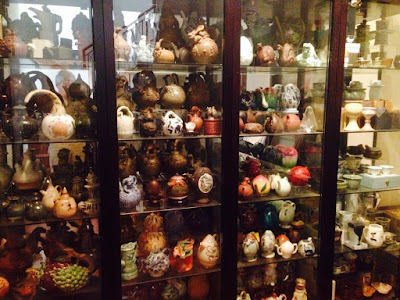Road Blocks won the Jury Honourable Mention Award at this year's IPP35 Nob Yoshigahara Puzzle Design Competition in Ottawa, Canada. This design comes from fellow Singaporean puzzler Goh Pit Khiam, whose other entry, "Number Blocks" also won the same award....two exact same awards in the same competition, a rarity indeed!
My copy of Road Blocks was bought from Tom Lensch, during the IPP35 Puzzle Party. Made of Maple for the box and pieces comprising of Bocote, Indian Rosewood, Yellowheart and Canarywood, the construction, fit and finishing is excellent. Dimensionally its about 4 inches or so square and about one and quarter inch thick. Nice size!
My copy came unsolved. The object of the puzzle is to fill the four (almost) identical shaped pieces into the box. Not really your usual packing puzzle as you will notice the inside of the box is surrounded by a channel and each of the pieces is formed by two squarish flat blocks of wood sandwiching a third which protrudes. It would be obvious that the blocks are not going to go in straight just like that into the box. Like a lot of Goh Pit Khiam designed puzzles, this is a packing puzzle which although looks relatively simple in appearance, is anything but.
To solve this puzzle, careful study of the pieces and the inside construction of the box and how the pieces and the box interact is necessary. This will save a lot of unnecessary headache as randomly trying to insert the pieces won't work here. In some ways, the Road Blocks puzzle brings to my mind another puzzle, Bill Cutler's famous Blockhead. Somewhat similar principle but not quite; Road Blocks comes with an added twist to it!
While it didn't take me long to solve, this puzzle is breeze through either.
An experienced puzzler would figure things out after a while but to the uninitiated, Road Blocks can prove to be very challenging. But it satisfies with a nice solution nonetheless!
Overall a great (3D) packing puzzle and truly well deserving of the IPP Award. A must have for collectors and packing puzzle enthusiasts. From what Tom tells me, he will be making more copies in the coming months, so drop him an email via his site if you wish to purchase one.
My copy of Road Blocks was bought from Tom Lensch, during the IPP35 Puzzle Party. Made of Maple for the box and pieces comprising of Bocote, Indian Rosewood, Yellowheart and Canarywood, the construction, fit and finishing is excellent. Dimensionally its about 4 inches or so square and about one and quarter inch thick. Nice size!
My copy came unsolved. The object of the puzzle is to fill the four (almost) identical shaped pieces into the box. Not really your usual packing puzzle as you will notice the inside of the box is surrounded by a channel and each of the pieces is formed by two squarish flat blocks of wood sandwiching a third which protrudes. It would be obvious that the blocks are not going to go in straight just like that into the box. Like a lot of Goh Pit Khiam designed puzzles, this is a packing puzzle which although looks relatively simple in appearance, is anything but.
To solve this puzzle, careful study of the pieces and the inside construction of the box and how the pieces and the box interact is necessary. This will save a lot of unnecessary headache as randomly trying to insert the pieces won't work here. In some ways, the Road Blocks puzzle brings to my mind another puzzle, Bill Cutler's famous Blockhead. Somewhat similar principle but not quite; Road Blocks comes with an added twist to it!
While it didn't take me long to solve, this puzzle is breeze through either.
An experienced puzzler would figure things out after a while but to the uninitiated, Road Blocks can prove to be very challenging. But it satisfies with a nice solution nonetheless!
Overall a great (3D) packing puzzle and truly well deserving of the IPP Award. A must have for collectors and packing puzzle enthusiasts. From what Tom tells me, he will be making more copies in the coming months, so drop him an email via his site if you wish to purchase one.











